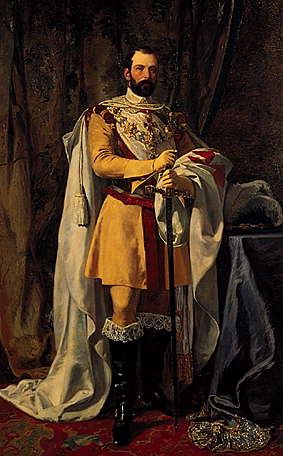The Royal Order of Karl XIII is one of the many Swedish royals order that still exists and is in use. The Order was founded by King Karl XIII of Sweden and Norway in 1811. Since 1811 and until this day, the Master of the Order is the regent of Sweden, so the current Order Master is His Majesty King Carl XVI Gustaf.
The insignia of the Royal Order of Karl XIII consists of a red St George cross in the centre a white globe with the monogram of the institutor, two opposite letters C surrounding XIII, in gold. The Royal Order of Karl XIII has their costume, but unlike the others, the costume is still used during ceremonies within the Swedish Freemasonry Order. The bodysuit is in yellow and velvet, with white and red details.

King Karl XV of Sweden and Norway in the costume of the Royal Order of Karl XIII. Photo: National Museum via Wikipedia Commons.
Membership of the Order can only be conferred on Freemasons of the Protestant faith. All princes of the Royal House of Sweden are members from birth, but can not wear the insignia unless they are Knights and Commanders Red Cross of the Swedish Order of Freemasons. There can never be more than 33 people who are members at the same time. Men of royal blood are automatically members and do not count as part of the 33 allotted slots.
The order has almost only been given to other royals. In addition, foreign royals have received the order. His Royal Highness Prince Edward, Duke of Kent was admitted to the Order on 6 November 2000. Since the order was established, more than 100 people have received to order.

King Oscar II of Sweden and Norway in the costume of the Royal Order of Karl XIII. Photo: National Museum via Wikipedia Commons.
His Majesty King Karl XIII was born on 7 October 1748. He was king of Sweden from 1809 and of Norway from 1814 until his death in 1818. He was the second son of King Adolf Frederick of Sweden and Louisa Ulrika of Prussia, sister of King Frederick II of Prussia. By the time he became King, he was 60-years-old and prematurely decrepit.
One of Napoleon’s generals, Jean-Baptiste Bernadotte, was chosen as his successor. The new crown prince took over the government as soon as he landed in Sweden in 1810. By the Union of Sweden and Norway on 4 November 1814, Karl became King of Norway under the name Karl II of Norway. After eight years as king only by title, Charles died without a natural heir on 5 February 1818, and Bernadotte succeeded him as King Karl Johan.

